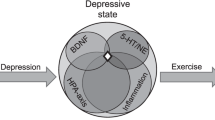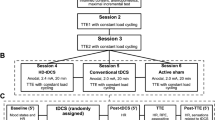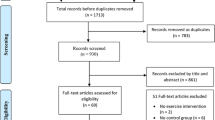Abstract
Episodes of short high intensity exercise are associated with an increase in circulating total testosterone (T) in men. Mechanisms may include hemoconcentration, decreased metabolic clearance and/or increased synthesis. Beta-blockade abolishes the T response suggesting a direct beta-adrenergic effect on the testes. Some spinal cord injured (SCI) athletes deliberately induce autonomic dysreflexia (boosting) to enhance performance. Associated with this practice are elevated catecholamine (CA) levels and exaggerated responses to serum catecholamine levels. Since basal T levels are reported to be normal in the SCI male, the T response to acute high intensity exercise might be expected to be exaggerated by boosting and associated elevated CA levels. The acute exercise T response has not been examined in SCI men to date. To determine whether the increased CA values associated with boosting enhanced the exercise-induced T elevation we measured circulating levels of T, Cortisol (C), norepinephrine (NE) and epinephrine (E) before and after maximal exertion and a simulated 7.5 km race with and without boosting in eight elite quadriplegic athletes. Maximal incremental exercise and a simulated 7.5 km race resulted in a rise in T similar to able bodied men under normal exercise conditions. Under boosted conditions the rise in T was eliminated while NE levels were significantly elevated above unboosted levels. The data may suggest an inhibitory role for CA on T production or release under conditions of extreme stress. Other possible mechanisms include C induced suppression, impaired gonadotropin stimulation of the Leydig cell and CA mediated alterations in gonadal blood supply.
Similar content being viewed by others
Log in or create a free account to read this content
Gain free access to this article, as well as selected content from this journal and more on nature.com
or
References
Sutton J R, Coleman M J, Casey J, Lazarus L (1973) Androgen responses during physical exercise. BMJ 1: 520–522.
Mathur D N, Toriola A L, Dada O A (1986) Serum Cortisol and testosterone levels in conditioned male distance runners and non-athletes after maximal exercise. J Sports Med Phys Fitness 26: 245–250.
Kindermann W, Schnable A, Schmitt W M, Biro G, Hippchen M (1982) Catecholamines, STH, Cortisol, Glucagon, Insulin und Sexualhormone bei Korperlicher Belasting und beta-blockade. Klin Wolrenschr 60: 505–512.
Cumming D C, Brunsting L A, Strich G, Ries A L, Rebar R W (1986) Reproductive hormone increases in response to acute exercise in men. Med Sci Sports Exerc 18: 369–373.
Cumming D C, Wheeler G D, McColl E M (1989) The effects of exercise on reproductive function in men. Sports Med 7: 1–17.
Tanaka H, Cleroux J, de C hamplain J, Ducharme J R, Collu R (1986) Persistent effects of a marathon run on the pituitary-testicular axis. J Endocrinol Invest 9: 97–101.
Schurmeyer T, Jung K, Nieschlag E (1984) The effects of an 110 kilometer run on testicular adrenal and thyroid hormones. Int J Androl 7: 276–282.
Morville R, Pesquies P C, Guezzenec C Y, Serrurier B D, Guignard M (1979) Plasma variations in testicular and adrenal androgens during prolonged physical exercise in man. Annales d'Endocrinologie (Paris) 40: 501–510.
Dessypris K, Kuoppasalmi K, Adlercreutz H (1976) Plasma Cortisol, testosterone, androstenedione and luteinizing hormone (LH) in a non-competitive marathon run. J Steroid Biochem 7: 33–37.
Cumming D C, Wheeler G D (1990) Exercise-associated changes in reproduction: a problem common to men and women. Frisch RE, editor. Adipose tissue and reproduction. Progress in Reproductive Biology and Medicine. Karger, Basel, 14: 125–135.
Wheeler G D, Wall S R, Beicastro A N, Conger P, Cumming D C (1984) Reduced serum testosterone and prolactin levels in male distance runners. JAMA 214: 514–516.
Wheeler G D, Symbaluk D, Pierce W D, McFadyan S, Cumming D C (1992) Decreased testosterone and elevated serum Cortisol in wrestlers. Clin Sports Med 2: 257–260.
Wilkerson J E, Horvath S M, Gutin B (1980) Plasma testosterone during treadmill exercise. J Appl Physiol 49: 249–253.
Eik-Ness K B (1964) On the relationship between testicular blood flow and secretion of testosterone in anesthetized dogs stimulated with human gonadotropin. Can J Physiol Pharmacol 42: 671–677.
Levin J, Lloyd C W, Lobotsky J, Friedrich E H (1967) The effect of epinephrine on testosterone production. Acta Endocrinol 55: 184–192.
Galbo H, Hummer L, Petersen L B, Christensen N J, Bie N (1977) Thyroid and testicular responses to graded and prolonged exercise in man. Eur J Appl Physiol 36: 101–106.
Jezova D, Vigas M (1981) Testosterone response to exercise during blockade and stimulation of adrenergic receptors in man. Horm Res 15: 141–147.
Hirsh I H, Sedor J, Callahan H J, Staas W E (1990) Systemic sperm autoimmunity in spinal cord injured men. Arch Androl 25: 69–73.
Ver V oort S M (1987) Infertility in spinal cord-injured male. Urology 24: 157–165.
Naftchi N E, Viau A T, Heiner-Sell G, Lowman E W (1980) Pituitary-testicular axis dysfunction in spinal cord injury. Arch Phys Med Rehabil 61: 402–405.
Claus-Walker J, Scurry M, Carter C E, Campos R J (1977) Steady state hormonal secretion in traumatic quadriplegia. J Clin Endocrinol Metab 44: 530–535.
Mizutani S, Sonoda T, Matsumoto K, Iwasa K (1972) Plasma testosterone concentration in paraplegic men. J Endocrinol 54: 363–364.
Hayes P J, Krishnan K R, Diver M J, Hipkin L J, Davis J C (1979) Testicular endocrine function in paraplegic men. Clin Endocrinol 11: 549–552.
Morley J E, Distiller L A, Lissoos I, Lipschizt R, Kay G, Searle D L et al 1979 Testicular function in patients with spinal cord damage. Horm Metab Res 11: 679–682.
Finsen V, Indredavik B, Fougner K J (1992) Bone mineral and hormone status in paraplegics. Paraplegia 30: 343–347.
Burnham R, Wheeler G D, Bhambhani Y, Belanger M, Eriksson P, Steadward R D (1994) Intentional induction of autonomic dysreflexia for performance enhancement in wheelchair athletes. Clin J Sport Med 4: 1–10.
Mathias C J, Christensen N J, Corbett J L, Frankel H L, Spalding J M K (1976) Plasma catecholamines during paroxysmal neurogenic hypertension in quadriplegic man. Circ Res 39: 204–208.
Phelps G, Brown M, Chen J, Dunn M, Lloyd E, Stefaniuk M L (1983) Sexual experience and plasma testosterone levels in male veterans after spinal cord injury. Arch Phys Med Rehabil 64: 47–52.
Perronet F, Beliveau L, Boudreau G, Trudeau F, Brisson G, Nadeau R (1988) Regional catecholamine removal and release at rest and exercise in dogs. Am J Physiol 254: R663–R672.
Braddom R L, Rocco J F (1991) Autonomic dysreflexia: A survey of current treatment. Am J Phys Med Rehabil 70: 234–241.
Bhambhani Y N, Eriksson P, Steadward R D (1991) Reliability of peak physiological responses during wheelchair ergometry in persons with spinal cord injury. Arch Phys Med Rehabil 75: 559–562.
Kreuz L E, Rose R M, Jennings J R (1972) Suppression of plasma testosterone levels and psychological stress. Arch Gen Psychiatry 26: 472–475.
Matsumoto K, Takeyasu K, Mizutani S, Hamanaka Y, Uozumi T (1970) Plasma testosterone levels following surgical stress in male patients. Acta Endocrinol 65: 11–17.
Lefkowitz K J (1979) Direct binding studies of adrenergic receptors: biological, physiological and clinical implications. Ann Intern Med 91: 450–458.
Setchell B P, Waites G M H, Thorburn G D (1966) Blood flow in the testis of the conscious rat measured with Krypton. Circ Res 18: 755–765.
Eik-Ness K B (1964) On the relationship between testicular blood flow and secretion of testosterone in anesthetized dogs stimulated with human chorionic gonadotropin. Can J Physiol Pharmacol 42: 671–677.
Armstrong D T, Hansel W (1958) Effects of hormone treatment on testes development and pituitary function. Int J Fertil 3: 296–306.
Author information
Authors and Affiliations
Rights and permissions
About this article
Cite this article
Wheeler, G., Cumming, D., Burnham, R. et al. Testosterone, cortisol and catecholamine responses to exercise stress and autonomic dysreflexia in elite quadriplegic athletes. Spinal Cord 32, 292–299 (1994). https://doi.org/10.1038/sc.1994.51
Issue date:
DOI: https://doi.org/10.1038/sc.1994.51
Keywords
This article is cited by
-
Role of exercise on visceral adiposity after spinal cord injury: a cardiometabolic risk factor
European Journal of Applied Physiology (2021)
-
Boosting in Elite Athletes with Spinal Cord Injury: A Critical Review of Physiology and Testing Procedures
Sports Medicine (2015)



